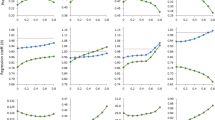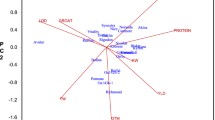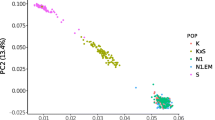Abstract
Genetic components for economically important traits in walnut (Juglans regia) were estimated for the first time using historical pedigree and heirloom phenotypic data from the walnut breeding program at the University of California, Davis. The constructed pedigree is composed of ~ 15,000 individuals and is derived from current and historic phenotypic records dating back > 50 years and located across California. To predict the additive genetic values of individuals under selection, generalized linear mixed models (GLMM), implemented with MCMCglmm, were developed. Several repeatability models were established to obtain the best model and predict the genetic parameters for each trait. Repeatability for yield, harvest date, extra-light kernel color (ELKC), and lateral bearing were predicted at 0.82, 0.98, 0.63, and 0.96, respectively, and average narrow-sense heritabilities were 0.54, 0.77, 0.49, and 0.75, respectively. Each individual in the pedigree was ranked by its estimated breeding value (EBV). The genetic trend showed specific patterns for each trait, and real genetic improvement was found over time. The completed pedigree built here, the estimated breeding values, and the ranking of individuals according to their breeding values, can be used to guide future crossing designs in the walnut breeding program and future implementation of genomic selection methods in walnut.




Similar content being viewed by others
References
Aletà N, Ninot A, Voltas J (2004) Retrospective evaluation of parental selection in nursery tests of Juglans regia L. using a mixed model analysis. Silvae Genet 53:26–33
Aparicio AG, Zuki SM, Azpilicueta MM, Barbero FA, Pastorino MJ (2015) Genetic versus environmental contributions to variation seedling resprouting in Nothofagus obliqua. Genet Genomes 11:23
Apiolaza LA, Chauhan SS, Walker JCF (2011) Genetic control of very early compression and opposite wood in Pinus radiata and its implications for selection. Tree Genet Genomes 7:563–571
Bauer A, Léon J (2008) Multiple-trait breeding values for parental selection in self-pollinating crops. Theor Appl Genet 116:235–242
Bink MCAM, Boer MP, ter Braak CJF, Jansen J, Voorrips RE, van de Weg E (2008) Bayesian analysis of complex traits in pedigreed plant populations. Euphytica 161:85–96
Bulmer MG (1980) The mathematical theory of quantitative genetics. Oxford University Press, Oxford
Burgueño J, Crossa J, Cornelius PL, Trethowan R, McLaren G, Krishnamachari A (2007) Modeling additive × environment and additive × additive × environment using genetic covariances of relatives of wheat genotypes. Crop Sci 43:311–320
Cappa EP, Yanchuk AD, Cartwright CV (2012) Bayesian inference for multi-environment spatial individual-tree models with additive and full-sib family genetic effects for large forest genetic trials. Ann For Sci 69:627–664
Coster A (2013) Pedigree: pedigree functions. R package version 1.4. https://CRAN.R-project.org/package=pedigree
Corrêa ER, Medeiros GCR, Barros WS, Bianchi VJ (2015) Evaluation and ranking of macadamia genotypes using mixed models. Afr J Agric Res 10:3696–3703
Crossa J, Burgueño J, Cornelius PL, McLaren G, Trethowan R, Krishnamachari A (2006) Modeling genotype × environment interaction using additive genetic covariances of relatives for predicting breeding values of wheat genotypes. Crop Sci 46:1722–1733
Crossa J, Burgueño J, Dreisigacker S, Vargas M, Herrera-Foessel SA, Lillemo M, Singh RP, Trethowan R, Warburton M, Franco J, Reynolds M, Crouch JH, Ortiz R (2007) Association analysis of historical bread wheat germplasm using additive genetic covariance of relatives and population structure. Genetics 177:1889–1913
Dangl G, Woeste K, Aradhya M, Koehmstedt A, Simon C, Potter D, Leslie CA, McGranahan GH (2005) Characterization of 14 microsatellite markers for genetic analysis and cultivar identification of walnut. J Am Soc Hortic Sci 130:348–354
de Souza VAB, Byrne DH, Taylor JF (2000) Predicted breeding values for nine plant and fruit characteristics of 28 peach genotypes. J Am Soc Hortic Sci 125:460–465
de Villemereuil P (2012) Estimation of a biological trait heritability using the animal model. How to use the MCMCglmm R package. http://devillemereuil.legtux.org/wpcontent/uploads/2012/12/tuto_en.pdf
de Villemereuil P, Gimenez O, Doligez B (2013) Comparing parent–offspring regression with frequentist and Bayesian animal models to estimate heritability in wild populations: a simulation study for Gaussian and binary traits. Methods Ecol Evol 4(3):260–275
Durel CE, Laurens F, Fouillet A, Lespinasse Y (1998) Utilization of pedigree information to estimate genetic parameters from large unbalanced data sets in apple. Theor Appl Genet 96:1077–1085
Falconer DS (1989) Introduction to quantitative genetics, Ed. 3 edn. Longmans Green/John Wiley & Sons, Harlow
Falconer DS, Mackay TFC (1996) Introduction to quantitative genetics, 4th edn. Longman Group Ltd, UK
Fernando RL, Gianola D, Grossman M (1983) Identifying all connected subsets in a two-way classification without interaction. J Dairy Sci 66:1399–1402
Fresnedo-Ramírez J, Frett TJ, Sandefur PJ, Salgado-Rojas A, Clark JR, Gasic K, Peace CP, Anderson N, Hartmann TP, Byrne DH, Bink MCAM, van de Weg E, Crisosto CH, Gradziel TM (2016) QTL mapping and breeding value estimation through pedigree-based analysis of fruit size and weight in four diverse peach breeding programs. Tree Genet Genomes 12:25
Gelman A, Carlin JB, Stern HS, Dunson DB, Vehtari A, Rubin DB (2014) Bayesian data analysis, Third edn. CRC Press, Boca Raton
Gianola D, Fernando RL (1986) Bayesian methods in animal breeding theory. J Anim Sci 63:217–244
Hadfield JD (2010) MCMC methods for multi-response generalized linear mixed models: the MCMCglmm R package. J Stat Softw 33:1–22
Hardner CM, Winks CW, Stephenson RA, Gallagher EG, McConchie CA (2002) Genetic parameters for yield in macadamia. Euphytica 125:255–264
Hardner CM, Bally IES, Wright CL (2012) Prediction of breeding values for average fruit weight in mango using a multivariate individual mixed model. Euphytica 186(2):463–477
Hayes BJ, Visscher PM, Goddard ME (2009) Increased accuracy of artificial selection by using the realized relationship matrix. Genet Res 91:47–60
Henderson CR (1949) Estimation of changes in herd environment. (Abstract). J Dairy Sci 32:706
Hendricks LC, Coates WC, Elkins RB, McGranahan GH, Philips H, Ramos D, Reil WO, Snyder RG (1998) Selection of varieties. In: Ramos DE (ed) Walnut Production Manual. University of California, Division of Agriculture and Natural Resources, Davis, pp 84–89. Pub. No. 3373
Hill WG (2010) Understanding and using quantitative genetic variation. Philos Trans R Soc B 365:73–85
Kouassi AB, Durel CE, Costa F, Tartarini S, van de Weg E, Evans K, Fernandez-Fernandez F, Govan C, Boudichevskaja A, Dunemann F, Antofie A, Lateur M, Stankiewicz-Kosyl M, Soska A, Tomala K, Lewandowski M, Rutkovski K, Zurawicz E, Guerra W, Laurens F (2009) Estimation of genetic parameters and prediction of breeding values for apple fruit-quality traits using pedigreed plant material in Europe. Tree Genet Genomes 5(4):659–672
Laviola BG, AMCE O, Bhering LL, Alves AA, Rocha RB, BEL G, Cruz CD (2013) Estimates of repeatability coefficients and selection gains in Jatropha indicate that higher cumulative genetic gains can be obtained by relaxing the degree of certainty in predicting the best families. Ind Crop Prod 51:70–76
Lee SH, Goddard ME, Visscher PM, van der Werf JHJ (2010) Using the realized relationship matrix to disentangle confounding factors for the estimation of genetic variance components of complex traits. Genet Sel Evol 42(1):22
Lynch M, Walsh B (1998) Genetics and analysis of quantitative traits. Sinauer, Sunderland
McGranahan GH, Forde HI (1985) Genetic improvement. In: Ramos DE (ed) Walnut orchard management. Univ. Calif. Div. Agr. Natural Resources, Oakland, pp 8–12
Mehrabani-Yeganeh H, Gibson JP, Schaeffer LR (1999) Effect of more stringent convergence criterion of estimated breeding values on response to selection. J Anim Breed Genet 116:339–349
Mrode RA, Thompson R (2005) Linear models for the prediction of animal breeding values. CABI Publishing, UK
Oakey H, Verbyla A, Pitchford W, Cullis B, Kuchel H (2006) Joint modeling of additive and non-additive genetic line effects in single field trials. Theor Appl Genet 113:809–819
Piepho HP, Möhring J, Melchinger AE, Büchse A (2008) BLUP for phenotypic selection in plant breeding and variety testing. Euphytica 161:209–228
Plummer M, Best N, Cowles K, Vines K (2006) CODA: convergence diagnosis and output analysis for MCMC. R News 6:7–11
R Core Team (2015) R: A language and environment for statistical computing. R Foundation for Statistical Computing, Vienna, Austria. http://www.R-project.org/
Resende MDV (2002) Genética biométrica e estatística no melhoramento de plantas perenes. Brasilia: Embrapa Informação Tecnológica, Colombo, Embrapa Florestas p. 975.
Shoemaker JS, Painter IS, Weir BS (1999) Bayesian statistics in genetics: a guide for the uninitiated. Trends Genet 15:354–358
Sorensen D, Gianola D (2002) Likelihood, Bayesian and MCMC methods in quantitative genetics. Springer-Verlag, New York, p. 740
Sorensen D, Gianola D (2010) Likelihood, Bayesian and MCMC methods in quantitative. Statistics for Biology and Health. Springer-Verlag, New York, p.740
Sorensen DA, Andersen S, Gianola D, Korsgaard I (1995) Bayesian inference in threshold models using Gibbs sampling. Genet Sel Evol 27:229–249
Thompson R, Meyer K (1986) A review of theoretical aspects in the estimation of breeding values for multi-trait selection. Livest Prod Sci 15:299–313
Tulecke W, McGranahan G (1994) The Walnut Germplasm Collection of the University of California, Davis. In: A Description of the collection and a history of the breeding program of Serr EF, Ford HI Report No. 13. University of California Genetic resources conservation program, Davis, CA pp 1–39
USDA NASS (2016) 2015 California walnut acreage report. National Agricultural Statistics Service 1–4.
Vazquez AI, Bates DM, Rosa GJM, Gianola D, Weigel KA (2010) Technical note: an R package for fitting generalized linear mixed models in animal breeding. J Anim Sci 88:497–504
Visscher PM, Macgregor S, Benyamin B, Zhu G, Gordon S, Medland S, Hill WG, Hottenga J-J, Willemsen G, Boomsma DI, Liu Y-Z, Deng H-W, Montgomery GW, Martin NG (2007) Genome partitioning of genetic variation for height from 11,214 sibling pairs. Am J Hum Genet 81:1104–1110
Waldmann P, Hallander J, Hoti F, Sillanpää MJ (2008) Efficient Markov Chain Monte Carlo implementation of Bayesian analysis of additive and dominance genetic variances in noninbred pedigrees. Genetics 179:1101–1112
Walsh B (2001) Quantitative genetics in the age of genomics. Theor Popul Biol 59:175–184
Xu S (2003) Advanced statistical methods for estimating genetic variation in plants. Plant Breed Rev 22:113–163
Xu S, Xu C (2006) A multivariate model for ordinal trait analysis. Heredity 97:409–417
Acknowledgments
We would especially like to thank the California Walnut Board for supporting this study.
Author information
Authors and Affiliations
Corresponding author
Ethics declarations
Conflict of interest
The authors declare that they have no conflict of interest.
Data archiving statement
All relevant data are presented in the main paper and in the Supplementary Materials. Supplemental file 1 presents EBV for all traits and inbreeding coefficients. Appendix 1 presents the R code for our model.
Additional information
Communicated by M. Wirthensohn
Electronic supplementary material
ESM 1
(XLSX 1950 kb)
Appendix1 R code
Appendix1 R code
General mixed model used for yield, lateral bearing, and ELKC
Prior
R = list (V = 30, nu = 0.002), G = list (G1 = list (V = 10, n = 0.002), G2 = list (V = 5, n = 0.002))
Model (all random effects)
Traitmodel < − MCMCglmm (TRAIT, random = ~ animal + ID + location + year + age, pedigree = ped, family = “ordinal”, nitt = 500,000, burnin = 5000, thin = 20, verbose = F, pr = T, data = input, prior = prior).
General mixed model used for harvest date
Prior
R = list (V = 30, nu = 0.002), G = list (G1 = list (V = 10, n = 0.002), G2 = list (V = 5, n = 0.002))
Model (all random effects)
Traitmodel < − MCMCglmm (TRAIT, random = ~ animal + ID + location + year + age, pedigree = ped, family = “gaussian,” nitt = 500,000, burnin = 5000, thin = 20, verbose = F, pr = T, data = input, prior = prior)
Rights and permissions
About this article
Cite this article
Martínez-García, P.J., Famula, R.A., Leslie, C. et al. Predicting breeding values and genetic components using generalized linear mixed models for categorical and continuous traits in walnut (Juglans regia). Tree Genetics & Genomes 13, 109 (2017). https://doi.org/10.1007/s11295-017-1187-z
Received:
Revised:
Accepted:
Published:
DOI: https://doi.org/10.1007/s11295-017-1187-z




